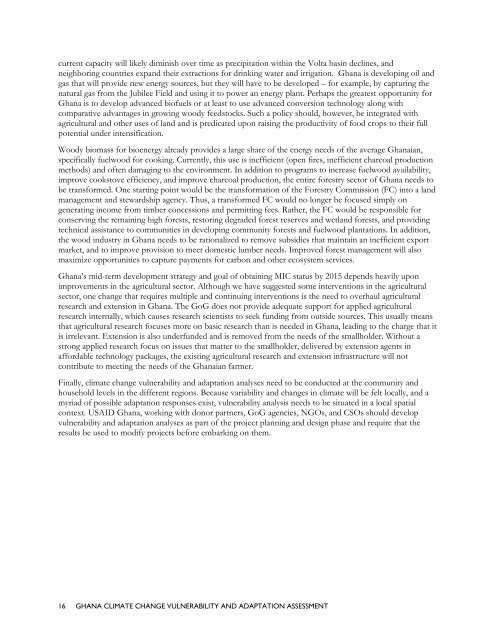ghana climate change vulnerability and adaptation assessment
ghana climate change vulnerability and adaptation assessment
ghana climate change vulnerability and adaptation assessment
- No tags were found...
Create successful ePaper yourself
Turn your PDF publications into a flip-book with our unique Google optimized e-Paper software.
current capacity will likely diminish over time as precipitation within the Volta basin declines, <strong>and</strong>neighboring countries exp<strong>and</strong> their extractions for drinking water <strong>and</strong> irrigation. Ghana is developing oil <strong>and</strong>gas that will provide new energy sources, but they will have to be developed – for example, by capturing thenatural gas from the Jubilee Field <strong>and</strong> using it to power an energy plant. Perhaps the greatest opportunity forGhana is to develop advanced biofuels or at least to use advanced conversion technology along withcomparative advantages in growing woody feedstocks. Such a policy should, however, be integrated withagricultural <strong>and</strong> other uses of l<strong>and</strong> <strong>and</strong> is predicated upon raising the productivity of food crops to their fullpotential under intensification.Woody biomass for bioenergy already provides a large share of the energy needs of the average Ghanaian,specifically fuelwood for cooking. Currently, this use is inefficient (open fires, inefficient charcoal productionmethods) <strong>and</strong> often damaging to the environment. In addition to programs to increase fuelwood availability,improve cookstove efficiency, <strong>and</strong> improve charcoal production, the entire forestry sector of Ghana needs tobe transformed. One starting point would be the transformation of the Forestry Commission (FC) into a l<strong>and</strong>management <strong>and</strong> stewardship agency. Thus, a transformed FC would no longer be focused simply ongenerating income from timber concessions <strong>and</strong> permitting fees. Rather, the FC would be responsible forconserving the remaining high forests, restoring degraded forest reserves <strong>and</strong> wetl<strong>and</strong> forests, <strong>and</strong> providingtechnical assistance to communities in developing community forests <strong>and</strong> fuelwood plantations. In addition,the wood industry in Ghana needs to be rationalized to remove subsidies that maintain an inefficient exportmarket, <strong>and</strong> to improve provision to meet domestic lumber needs. Improved forest management will alsomaximize opportunities to capture payments for carbon <strong>and</strong> other ecosystem services.Ghana’s mid-term development strategy <strong>and</strong> goal of obtaining MIC status by 2015 depends heavily uponimprovements in the agricultural sector. Although we have suggested some interventions in the agriculturalsector, one <strong>change</strong> that requires multiple <strong>and</strong> continuing interventions is the need to overhaul agriculturalresearch <strong>and</strong> extension in Ghana. The GoG does not provide adequate support for applied agriculturalresearch internally, which causes research scientists to seek funding from outside sources. This usually meansthat agricultural research focuses more on basic research than is needed in Ghana, leading to the charge that itis irrelevant. Extension is also underfunded <strong>and</strong> is removed from the needs of the smallholder. Without astrong applied research focus on issues that matter to the smallholder, delivered by extension agents inaffordable technology packages, the existing agricultural research <strong>and</strong> extension infrastructure will notcontribute to meeting the needs of the Ghanaian farmer.Finally, <strong>climate</strong> <strong>change</strong> <strong>vulnerability</strong> <strong>and</strong> <strong>adaptation</strong> analyses need to be conducted at the community <strong>and</strong>household levels in the different regions. Because variability <strong>and</strong> <strong>change</strong>s in <strong>climate</strong> will be felt locally, <strong>and</strong> amyriad of possible <strong>adaptation</strong> responses exist, <strong>vulnerability</strong> analysis needs to be situated in a local spatialcontext. USAID Ghana, working with donor partners, GoG agencies, NGOs, <strong>and</strong> CSOs should develop<strong>vulnerability</strong> <strong>and</strong> <strong>adaptation</strong> analyses as part of the project planning <strong>and</strong> design phase <strong>and</strong> require that theresults be used to modify projects before embarking on them.16 GHANA CLIMATE CHANGE VULNERABILITY AND ADAPTATION ASSESSMENT
















